
Shaku Nair, Dawn H. Gouge, Shujuan (Lucy) Li
Department of Entomology, University of Arizona
In this newsletter, we will cover two large, scary-looking insects that are actually quite docile and fascinating creatures. But do not be tempted to touch the impressive tarantula hawk. World renowned entomologist and adjunct faculty at the University of Arizona Justin Schmidt developed a Sting Pain Index to rank how painful insect stings are. Justin ranks female tarantula hawk stings as one of the most painful stings on the planet!
Tarantula hawk wasps (Pompilidae family)
These large dark wasps, also known as spider wasps, are commonly seen in landscapes from late spring through the fall in the desert southwest.
What do they look like? Measuring up to 2 inches in length as adults, these magnificent creatures are some of the largest wasps around (Figure 1).
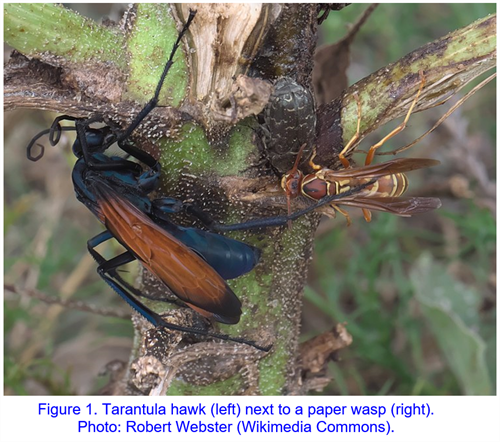
They have dark, shiny, black, or dark blue bodies, orange, black, or bronze-colored wings, very long, dark legs and antennae. Their bodies and wings are “iridescent”, meaning they appear to change color as you view them from different angles (Figure 2).
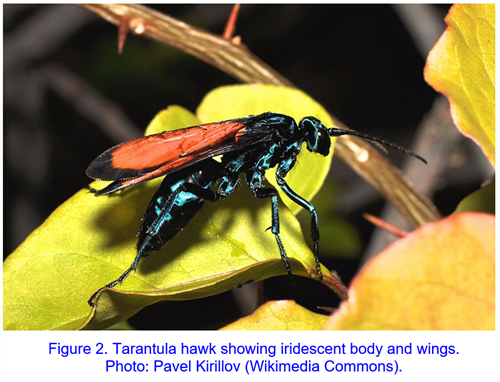
Why are they in my yard?
The adult wasps feed on nectar (Figure 3 left), pollen, and juice from fallen fruit. Feeding on fermenting fruit can lead to drunken collapsing (Figure 3 right) and uncoordinated flight. So, if you have fallen fruit in your yard, they may be foraging on that. Female adult tarantula hawks hunt tarantulas as food for their offspring.
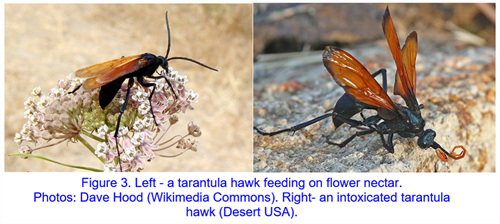
Cool facts about tarantula hawks:
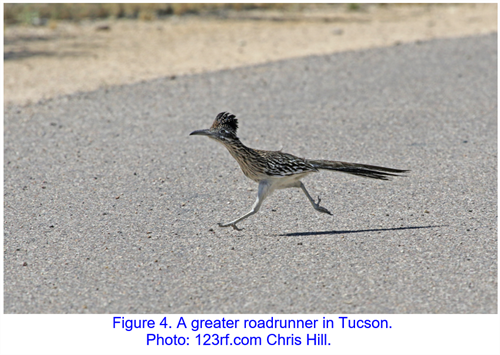
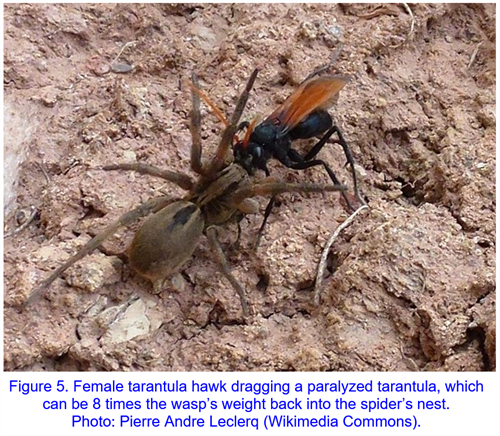
Should I worry about them? Generally, no. The males may guard their favorite hang-out location but have no stinger and are completely harmless. The females can sting, and it really packs a punch, but they are quite reluctant to sting, unless provoked. If they are repeatedly disturbed or threatened, they can give an extremely painful sting which typically subsides soon afterwards. Prolonged reactions are extremely rare.
Giant mesquite bug (Thasus neocalifornicus)
When Arizona temperatures rise into triple digits, immature giant mesquite bugs move down from the upper branches of mesquite trees to cluster in groups on the main trunk escaping the higher temperatures as it is cooler closer to the ground. They are rarely visible when up in the tree canopy but can alarm people when the brightly colored red and black bugs cluster in large numbers on the lower trunks of mesquite tree. The adults are the largest true bugs in the world, reaching almost 2 inches in length. They are harmless to humans.
What do they look like?
The adults are dark gray, brown, or black in color, with small heads. The antennae are dark brown or black at the base, but the top two segments are colored dark orange or red and the second segment from the tip has a distinct flattened, leaf-like enlarged area. Legs are black, with dark red patches or bands, femora (thighs) of hind legs are enlarged, with spines along their inner edge. Wings have prominent orange or yellow veins on a dark background (Figure 5).
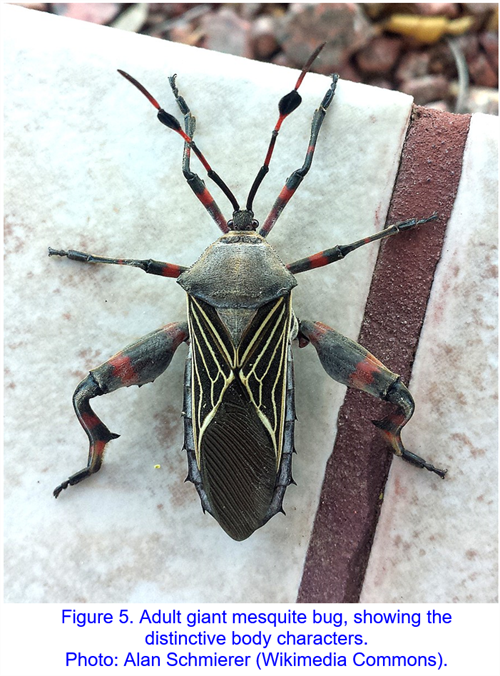
Nymphs (immatures) are patterned with vivid red, yellow, white, and black (Figure 6), and change patterns as they develop through five stages (instars). The leaf-like protuberance on the antennae is present in all stages.
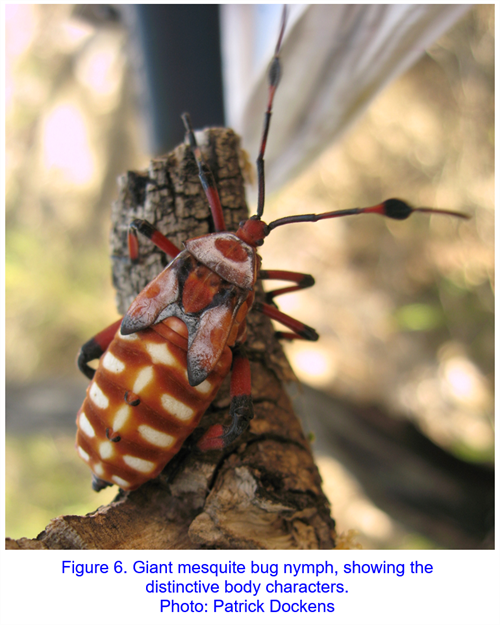
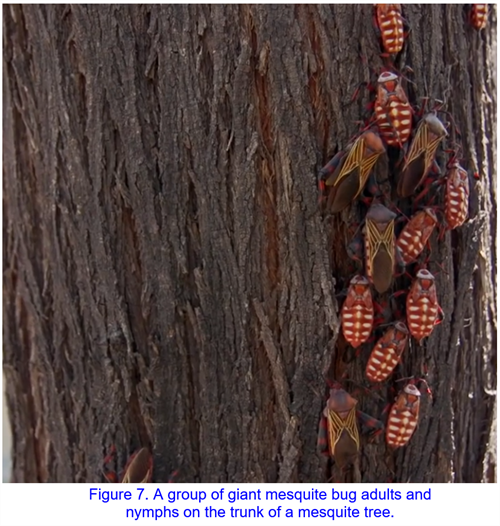
Adult mesquite bugs can cluster in small, loose groups. They are slow clumsy fliers. Nymphs (immatures) may occur in larger, tightly packed groups. Adults and nymphs may occur together on the same tree (Figure 7).
Why are they in my yard?
Giant mesquite bugs feed on mesquite pods and sap of mesquite trees. They may also be found resting on other garden and landscape plants but cause no damage.
Cool facts about giant mesquite bugs:
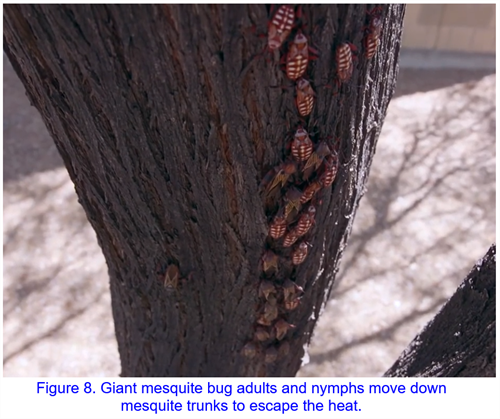
Should I worry about them? No. These bugs do not bite or sting humans. They feed only on mesquite pods. They can be mistaken for kissing bugs, squash bugs, and other large bugs. But the diamond-shaped antennal segment is a helpful identifying character. Figure 9 shows a comparison of sizes of some commonly observed bugs in our landscapes.
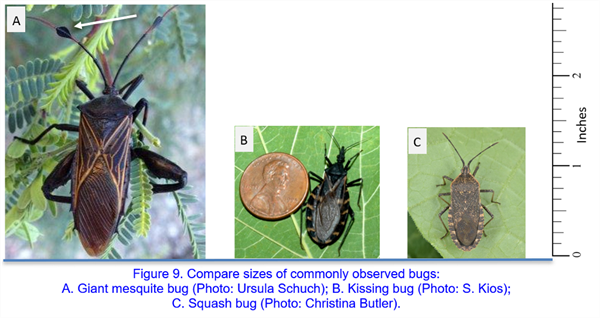
Read more about kissing bugs in our publication https://extension.arizona.edu/sites/extension.arizona.edu/files/pubs/az1787-2019.pdf
Read more about squash bugs in our publication https://cals.arizona.edu/yavapai/anr/hort/byg/archive/squashbugs2017.html
It is important to properly identify insects and other arthropods encountered in our environments before taking management actions. Many of these creatures are harmless or beneficial. When pests are identified taking an integrated pest management (IPM) approach is the most sensible, economical, and sustainable approach of managing pests in any situation, with the least possible risk to people, property, and the environment. IPM can be defined in numerous ways according to the situation, but common aspects in most definitions are prevention, regular monitoring and use of multiple compatible techniques (as opposed to relying on pesticide applications only) to reduce pest populations and maintain them at levels that do not cause injury or concern.
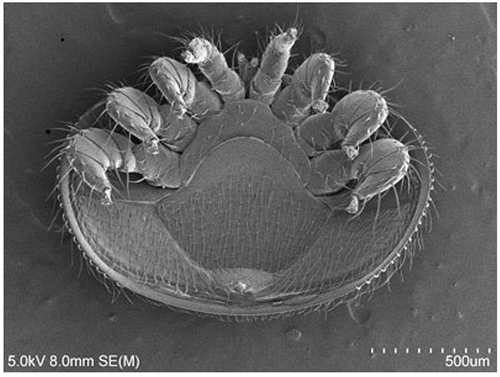
Answer: Varroa destructor also known as the Varroa mite which is a parasitic mite that feeds on honey bees
Congratulations to Proficient Pest Detectives J. Santos Portugal, ABC Home & Commercial Services and Michael G. Hansen, Michigan Department of Agriculture and Rural Development.
What the Heck are These?
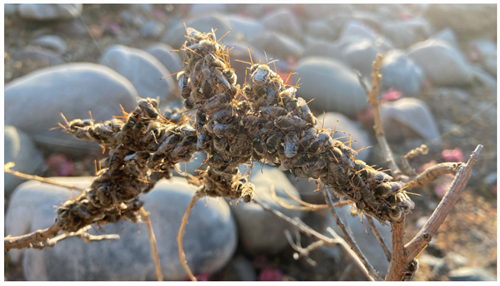
If you know what these are email the answer to Dawn at dhgouge@email.arizona.edu. You will not win anything if you are correct, but you will be listed as a “Proficient Pest Detective” in the next newsletter issue.
The Inter Tribal Council of Arizona, Inc. and Arizona Pest Management Center present “Emergency Preparedness for Outbreaks of Insect and Arthropod Vectors and Communicable Pests Workshop”. It is a two-day virtual workshop on Tuesday, May 25, 2021 & Wednesday, May 26, 2021. The workshop will offer 6 Arizona Structural (PMD) CEUs. For more information, please contact Ms. Monique Tsosie at Monique.Tsosie@itcaonline.com
Registration Link: https://forms.gle/mF2AJx93DXVaBVs69
Registration closing date: Monday, May 24, 2021 at 5:00 PM MST
The 4th Arizona School IPM Conference is being offered ONLINE April 19-May 31, 2021. The conference is a great opportunity for continuing education, professional development, and awareness building; consisting of engaging presentations for all persons involved with schools, childcare and similar facilities, and other sensitive environments; and anyone with an interest in ensuring safe, healthy learning and working environments. Listen to talks by experts on various aspects of school IPM, share your experiences and questions, and find solutions to pest issues your school is facing. Give feedback on topics you would like to see in future events. The conference will offer 6 or 12 Arizona PMD CEUs, 6 Arizona AG CEUs and 12 NEHA Registered Sanitarian Credits.
Registration and more information https://acis.cals.arizona.edu/community-ipm/events/arizona-school-ipm-conference.
Who can attend? Anyone with an interest in safe and effective pest management in schools, childcare and similar facilities. Typically, our audience includes school and other administrative staff, maintenance and operations staff, grounds and landscape managers, teachers, principals, nurses, parents, and pest control technicians, food service staff, facility managers, superintendents, medical professionals, students, and many others.
May 21, 2021, Live online 3 Tracks available until June 20, 2021.
The Desert Horticulture Conference is the premier annual conference for all members of the southwest green industry: landscape architects, designers, growers, retailers, contractors, maintenance personnel, suppliers, and educators. Presenting timely and research-based information relevant for designing, building, maintaining, and producing plants for urban landscapes in the arid Southwest.
Registration is open at: https://cals.arizona.edu/deserthort/.
Open now for on-demand CEs. To register contact Dr. Lucy Li lucyli@email.arizona.edu
The Vector Preparedness Virtual Workshop is a great opportunity for anyone with an interest in learning information on mosquito ID, surveillance, management, and insecticide resistance in public health pests.
This workshop will present:
1. Basic aspects of mosquito biology and ecology, vector disease risks, and identification of a few important problematic mosquitoes in Arizona.
2. Extensive information on integrated mosquito management.
3. Why it is important to trap mosquitoes, different types of traps that are available, and tips on how to use them.
4. Insecticide resistance, types of resistance (using bed bugs as examples), Integrated Pest Management (IPM), and public health pests IPM including bed bugs, head lice, German cockroaches, mosquitoes, flies, etc.
Arizona certified structural pesticide applicators can earn 4 CEUs from the AZ Department of Agriculture’s Pest Management Division (PMD) after completing the entire workshop. This course will be effective through August 30, 2021.
Check out upcoming Integrated Pest Management Webinars at https://www.epa.gov/managing-pests-schools/upcoming-integrated-pest-management-webinars
For more information about the EPA Schools program: http://www.epa.gov/schools/.
To view all our previous newsletters, visit: https://acis.cals.arizona.edu/community-ipm/home-and-school-ipm-newsletters.
Acknowledgements
This material is in part funded by the National Institute of Food and Agriculture, U.S. Department of Agriculture, under award number 2017-70006-27145 that provides Extension IPM funding to the University of Arizona. Information regarding this document is within the guidelines of the Border 2020 Program funded by the U.S. Environmental Agency (EPA) and administered by NADB. Additional support is provided by the U.A. – Arizona Pest Management Center.